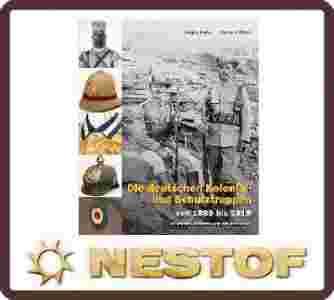OPIS
Przedmiotem aukcji jest monografia niemieckich
wojsk kolonialnych 1889 - 1918. Łącznie ponad
600
stron, bogato ilustrowanych ponad 1000 zdjęciami.
Książka w twardej oprawie, dodatkowo w obwolucie. Poniżej przykładowe zdjęcia z
książki.
Autorzy: Dr. phil. Jürgen Kraus, Dr.
phil. Thomas Müller
ISBN: 978-3-9[zasłonięte]02526-6 (wersja
niemiecka)
lub 978-3-9[zasłonięte]02526-4 (wersja angielska)
Waga: 3,20 kg
Dane Techniczne: 864 strony, ponad 2500
kolorowych zdjęć, łącznie ze współczesnymi fotografiami
i ilustracjami, zszyte w twardej oprawie. Format: 29.5 x 26.0 cm.
•
Publikacja wydawnictwa Verlag Militaria, wysoko
cenionego wśród kolekcjonerów i hobbystów
• Książkę wysyłamy w terminie
14 dni
od zaksięgowania wpłaty lub 20 % przedpłaty w
przypadku pobrania.
• Po zakupie proszę o informacje którą
wersję językową wysłać!
OPIS ANGLOJĘZYCZNY
This 600-page illustrated volume deals first with
the history of Germany’s colonial ambition, thus
providing a historical and political framework.
Starting with the first tentative colonisation
projects, this part of the book concentrates on the
years between 1884 (the establishment, under
Imperial constitutional law, of the first ‘protectorate’)
and 1919, the formal end of Germany’s colonial
Empire with the Treaty of Versailles. It describes
the motives of a country striving to obtain ‘a place
in the sun’ and the initial reluctance of Reichs
Chancellor Bismarck, who eventually conceded to the
idea of colonisation, and then deals in detail with
the security organisation in the protectorates as
well as the special case of Jiaozhou, China. This
introductory section closes with the campaigns and
military operations prior to the First World War and
the occurrences during the War, 1914 to 1918.
The second part deals with the uniforms and
equipment of the Schutztruppen: based on the early
uniforms worn from 1889 in German East Africa and
German South-West Africa, the universal uniform for
all ‘Imperial Schutztruppen’ was established in
1896. Along with the representative grey home
uniform, this also included a sand-coloured or white
tropical uniform adapted to the climate in the
protectorates. In 1913, the field grey uniform was
finally introduced. Despite the basic form, uniforms
and equipment varied in the protectorates. All the
various items, such as pith helmets, caps, tunics
and cartridge belts, are described here in great
detail. The African soldiers’ tropical uniform is
also dealt with in a special section. The troops for
East Asia presented a completely different picture.
Initially, the East Asia Expeditionary Corps, sent
out in 1900, was only issued an improvised uniform,
which made quite an exotic impression with its straw
hats. By 1901 the troops were issued special field
grey winter and summer uniforms with brand new
helmets, pith helmets, tunics and equipment. These
items were not only worn by the East Asia Occupation
Troops until 1909, they also became trial models in
the search for a new field uniform and many
important elements were later incorporated into the
field uniform of the German Army.
OPIS NIEMIECKOJĘZYCZNY
Dieser rund 600 Seiten umfassende Text-Bildband geht
zunächst auf die Geschichte deutschen Kolonialstrebens
ein und setzt somit einen historisch-politischen Rahmen.
Ausgehend von den ersten zaghaften
Kolonisierungsprojekten konzentriert sich der erste Teil
des Buches auf die Jahre zwischen 1884 (der
staatsrechtlichen Etablierung des ersten „Schutzgebietes“)
und 1919, dem formalen Ende des deutschen
Kolonialreiches infolge des Versailler Vertrages. Er
schildert die Motive der „nach einem Platz an der Sonne“
strebenden Deutschen, den Widerwillen des schließlich
doch kurzfristig nachgebenden „saturierten“
Reichskanzlers v. Bismarck gegenüber Kolonien, um sich
dann ausgiebig mit der Sicherheitsorganisation in den
Schutzgebieten sowie mit dem kolonialen „Sonderfall“
Kiautschou zu befassen. Die Feldzüge und militärischen
Operationen der Vorkriegszeit und die Kriegsereignisse
zwischen 1914 und 1918 schließen diesen Teil ab.
Im zweiten Teil wird die Bekleidung und Ausrüstung der
Schutztruppen behandelt. Aufbauend auf den Anfängen der
Schutztruppen in Deutsch-Ost- und -Südwestafrika seit
1889, wurde 1896 eine einheitliche Bekleidung für alle „Kaiserlichen
Schutztruppen“ festgelegt. Neben einer repräsentativen
grauen Heimatuniform umfasste sie eine zweckmäßige
sandfarbene oder weiße Tropenuniform, die dem Klima in
den Schutzgebieten angepasst war. 1913 kam es noch zur
Einführung einer feldgrauen Bekleidung. Trotz der
einheitlichen Grundform bestanden zwischen den
Schutzgebieten gewisse Unterschiede in der Bekleidung
und Ausrüstung. Die verschiedenen Anzugsarten werden in
ihren einzelnen Bestandteilen wie Tropenhelmen, Mützen,
Röcken oder Patronengürteln ausführlich behandelt. Auch
der Tropenuniform der farbigen Soldaten ist ein eigener
Abschnitt gewidmet.
Ein vollkommen anderes Bild boten die für Ostasien
bestimmten Truppen. Zunächst konnte das im Jahre 1900
ausgesandte Ostasiatische Expeditionskorps nur eine
improvisierte Uniformierung erhalten, die mit Strohhüten
einen exotischen Eindruck erweckte. Doch bereits seit
1901 erhielten die Truppen eine speziell geschaffene
feldgraue Winter- und Sommerbekleidung mit völlig neu
entwickelten Helmen, Tropenhelmen, Waffenröcken und
Ausrüstungsteilen. Diese Bekleidungsstücke wurden nicht
nur von den Ostasiatischen Besatzungstruppen bis 1909
getragen, sondern dienten zugleich als Versuche für eine
in der Heimat angestrebte neue Felduniform. Tatsächlich
flossen wichtige Elemente in die spätere Felduniform des
deutschen Heeres ein.GALERIA
[Kliknij na zdjęcie żeby powiększyć]








| | |

